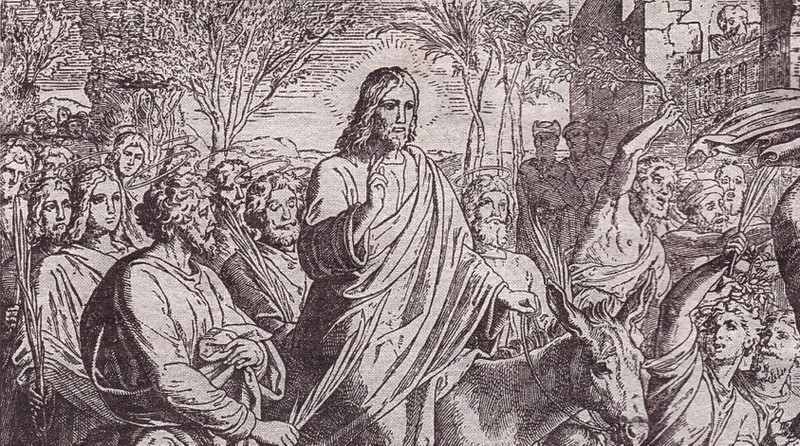Jesus Enters Jerusalem: The Triumphal Entry
"Now when they drew near to Jerusalem and came to Bethphage, to the Mount of Olives, then Jesus sent two disciples, saying to them, "Go into the village in front of you, and immediately you will find a donkey tied, and a colt with her. Untie them and bring them to me. If anyone says anything to you, you shall say, 'The Lord needs them,' and he will send them at once."
This took place to fulfill what was spoken by the prophet, saying, "Say to the daughter of Zion, 'Behold, your king is coming to you, humble, and mounted on a donkey, and on a colt, the foal of a beast of burden.'"
The disciples went and did as Jesus had directed them. They brought the donkey and the colt and put on them their cloaks, and he sat on them. Most of the crowd spread their cloaks on the road, and others cut branches from the trees and spread them on the road. And the crowds that went before him and that followed him were shouting, "Hosanna to the Son of David! Blessed is he who comes in the name of the Lord! Hosanna in the highest!" And when he entered Jerusalem, the whole city was stirred up, saying, "Who is this?" And the crowds said, "This is the prophet Jesus, from Nazareth of Galilee." - Matthew 21:1-11
All four Gospels offering unique details to the events of Palm Sunday:
Matthew 21:1-11 emphasizes the fulfillment of prophecy, noting that Jesus instructs two disciples to fetch a donkey and its colt. He rides the colt, symbolizing humility and peace, fulfilling Zechariah's prophecy. The crowd spreads cloaks and branches on the road, shouting, "Hosanna to the Son of David!"
Mark 11:1-11 provides a concise account, mentioning Jesus sending two disciples to retrieve a colt. As He rides into Jerusalem, people spread cloaks and leafy branches, proclaiming, "Hosanna! Blessed is he who comes in the name of the Lord!"
Luke 19:28-44 focuses on the crowd's reaction, describing how they spread their cloaks on the road and joyfully praise God for Jesus' miracles, saying, "Blessed is the king who comes in the name of the Lord!" Notably, Luke omits the mention of palm branches. As Jesus approaches Jerusalem, He weeps over the city, foretelling its future destruction.
John 12:12-19 is the only Gospel explicitly mentioning palm branches. It highlights the crowd meeting Jesus with palm branches, shouting, "Hosanna! Blessed is he who comes in the name of the Lord, even the King of Israel!" John connects this event to the recent raising of Lazarus, indicating the crowd's enthusiasm stems from witnessing this miracle.
Read more: Palm Sunday Scriptures
Why did Jesus ride a Donkey?
When Jesus entered Jerusalem on Palm Sunday, He chose to ride a donkey rather than a horse or walk on foot. This wasn’t just a random choice—it was full of symbolic meaning and fulfilled ancient prophecy.
Zechariah 9:9 had foretold this event centuries earlier, saying, “Behold, your king is coming to you; righteous and having salvation is he, humble and mounted on a donkey.” By choosing to ride a donkey into Jerusalem, Jesus was making a bold declaration: He was the long-awaited Messiah, the King Israel had been expecting.
But His choice of a donkey wasn’t just about fulfilling prophecy—it was also deeply symbolic. In ancient times, kings rode warhorses when they came to conquer, but they rode donkeys when they came in peace. Jesus wasn’t arriving as a warrior ready to overthrow Rome; He was coming as a King of peace, bringing salvation through humility and sacrifice.
Riding a donkey also reflected His humility. Unlike a warhorse, a donkey was a simple, lowly animal, often used by common people. This choice echoed Jesus’ entire mission—He wasn’t coming as a political or military leader, but as the Suffering Servant, the one who would lay down His life for the world.
Palm Sunday in 2025
This year, Palm Sunday will be on Sunday April 13, 2025. This begins Holy Week, leading to Easter on Sunday, April 20th, 2025.
See the timeline and meaning of Holy Week: When Is Holy Week in 2025? Holiday Dates for Easter and More
Photo Credit: Wikipedia





.jpg)

